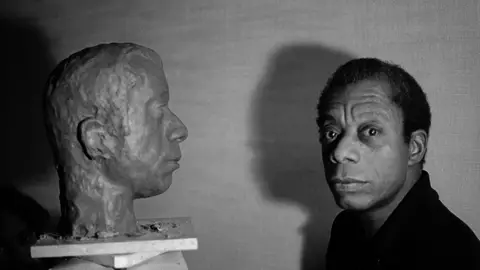Hilton Als on the Many Faces of James Baldwin

The tendency to exalt the dead often results in the loss of some aspect of their humanity. James Baldwin has been dead for more than 30 years, but he is arguably more relevant now than ever, with renewed interest in his work bearing fruit most recently in the award-winning If Beale Street Could Talk.
Though the author's estate has loosened its grip on his archives, this resurgence of interest in James Baldwin is, according to Pulitzer Prize-winner Hilton Als, also due in part to Baldwin's "ability to analyze and articulate how power abuses through cunning and force and why, in the end, it’s up to the people to topple kingdoms."
Baldwin has become a posthumous but prophetic voice for The Resistance.
James Baldwin by Richard Avedon
"I think he would’ve been horrified politically, of course," Als says of Baldwin in the era of Trump, "but I think he also would’ve been very interested in the American character coming back to the kind of racism that his parents tried to escape from in the South. I think he would’ve been interested in the regression, but as a writer, interested in why we regress."
But for Als, the impetus behind his exhibit, God Made My Face: A Collective Portrait of James Baldwin— open through February 16 at New York's David Zwirner Gallery—was to get to the man behind the legend, "specifically his sexuality and aestheticism" as factors in informing Baldwin's politics.
"I had grown up enough to approach him as an artist, not as someone that I wanted to be," says Als. "Someone I just thought we could look at free of the impulse to canonize him, to make him bloodless and a mouthpiece for these very confusing times."
Though Baldwin had been a part of his life since reading Notes of a Native Son through a junior high book-a-month club, for God Made My Face, Als spent months trying to understand Baldwin—through archival information, traveling to Baldwin's adopted country of France, and revisiting his works. Ultimately, Als came away with a desire to facilitate a conversation on black masculinity, and what that meant to Baldwin.
"I was just thinking how this conversation, in an art context, started with Black Male," Als says, referring to the 1994 exhibit curated by the Whitney Museum's Thelma Golden, the catalog of which Als edited. "When I was working on it with her the conversation really was a frightening one to have and I think it’s still a very touchy conversation for Americans to have. And for sure it was one of Baldwin’s subjects: What does the black man look like, not only to whiteness, but to himself—as informed by all these truly schizoid and insane ideas about sexuality and maleness, in general, but black masculinity in particular?"
Beauford Delaney, Dark Rapture (James Baldwin), 1941
Eschewing the tried and true portraits of Baldwin to which we've grown accustomed—coolly detached at civil rights marches or grinning beatifically at the camera—Als divides his collective portrait into two sections: "A Walker in the City," centering Baldwin's youth and his "aesthicization as a gay man" in Harlem and later in Paris; and "Colonialism," which explores how Baldwin was "gradually colonized" by fame and, through the work of other artists, seeks to fulfill Baldwin's artistic ambitions.
Als continues, "What would it have been like for him to exercise his desire to have been a filmmaker, to have been a visual artist himself, where would it have taken him? It’s almost as if we’re making the work that he didn’t make."
While Baldwin wrote boldly and eloquently about race in America, and Giovanni's Room stands among the greatest works of queer literature—albeit from a decidedly white perspective—Baldwin never truly reconciled the two themes to form a definitive work on black queerness—at least he never got a chance to finish it.
"In doing research, I interviewed an editor of his and he was working on a novel that was specifically about that," Als recalls. "This is the era when people were arrested and careers were destroyed because of it [homosexuality], so I think if he could fictionalize it with a white person to distance himself as the protagonist, this was a way to speak but not be seen. So I think he did the best he could with the information he had and the times he had."
So what revelations, if any, does God Made My Face give the viewer about James Baldwin? Nothing more, perhaps, than he was simply a man—not an oracle, not a prophet—with human desires, with regrets and shortcomings, who nevertheless can serve as an example for all of us hoping to make sense of an often senseless world.
"I think that there’s no blanket statement about any sexuality or any race. What is important is that you reckon with your own self," Als says. "That is what Baldwin is such a profound example of. This is a person who came from extreme deprivation to live in a European capital and to live in the world as a citizen. I think he reckoned with himself as much as he could, as much as any human could, so I think that’s our job and responsibility—to reckon with ourselves."





